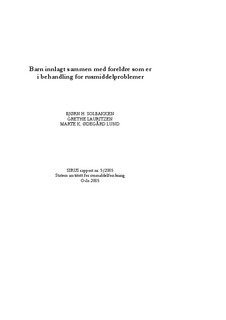Barn innlagt sammen med foreldre som er i behandling for rusmiddelproblemer
Research report
Permanent lenke
http://hdl.handle.net/11250/275961Utgivelsesdato
2005Metadata
Vis full innførselSamlinger
Originalversjon
SIRUS-rapport. 124 p. Statens institutt for rusmiddelforskning, 2005Sammendrag
Rapporten er en av to delrapportersom er skrevet etter oppdrag fraBarne- og familiedepartementet. Mål medprosjektet har vært å få en størrekunnskap om hvilken hjelp barn med rusmiddelmisbrukende foreldretilbys i Norge. Barna anses i et oppvekst- og levekårsperspektiv å væreensvært sårbar gruppe med stor risiko for problemutvikling.Denne rapporten omhandler tilbud til barn innlagt sammen med foreldresom er i behandling for rusmiddelproblemer. Barne- og familie-departementet har bedtom en oversikt over institusjoner som gir slikttilbud, hvor mange barn som benytter det, hva tilbudet til barnainneholder, hvilken bemanning institusjonene har for å ivareta barnasbehov, rutiner for samarbeid med hjelpeapparatet og skole/barnehage,hvordan barna ivaretas når foreldreneskrives ut, og om institusjoneneevaluerer sin praksis på området. Dethar også vært ønskelig å synliggjørebehovet for videre fagutvikling ogforskning.Det viste seg å ikke foreligge enkelt tilgjengelige oversikter overinstitusjoner som gir tilbud om innleggelse av barn sammen med foreldre.Via ulike kilder har vi funnet frem til ni behandlingsinstitusjoner innenforrusmiddelfeltet hvorav en har en overordnet omsorgsideologi. Vi har ogsåinkludert to barnevern-/foreldre-barn-sentre som er sentrale fagligeaktører i dette arbeidet. Defleste avinstitusjonene har utviklet tilbudene tilbarn fra første halvdel av 1990 årene,og tre av tiltakene er etablert etter2003. Vi har gjennomført en spørreundersøkelse overfor disse 11institusjonene med supplerende innhenting av opplysninger.Underveis i prosjektperioden har vi dessuten forsøkt å kartlegge tilbudet tilbarn av rusmiddelmisbrukende mødre i familie-barn sentre, knyttet tilbarnevern- og sosialtjeneste. De vari utgangspunktet definert utenfor vårtmandat, da de ikke er behandlingstiltak. Informasjonene herfra er ikkeinkludert som del av undersøkelsens utvalg, men nevnes kort, og vi serbehovet for å søke ytterligere informasjon om deres virksomhet. The Ministry wanted SIRUS to ascertain which inpatient treatment units include admissions of children in their treatment of parents for substance abuse problems, how many children are involved, what assistance is given to the children, the kind/amount of professions working with them, routines for co-operation with welfare officials (including kindergartens/schools), how these children are followed up after their parents complete treatment and whether the institutions have evaluated their work.
There was no readily accessible overview of Norwegian institutions providing admission to children along with their parents. Through various sources, nine inpatient treatment units were found that offered such assistance. Two childcare and parent-children centres that play central roles in related work were also included. Information was acquired through a questionnaire sent to these 11.
In 2004 there were 161 children admitted to the institutions and 93 % of them were under the age of three, 64 % under age one. About a quarter of the children were born during their mothers’ institutional residence. For preventive reasons, priority was given to admitting children from an early age and mothers from an early pregnancy. The length of stays in treatment units varied widely. Half of the institutions reported using standard tools for making assessments of the children. Those who used such tools were more likely to report negative effects and dysfunctions among the children. However, a high frequency of functional and developmental problems appeared to be linked to prenatal and early-years exposure to substances.
High professional competence prevails in most of the institutions but there is a considerable need for specific initiatives to train and instruct in observation and clarification of children’s developmental damage and relationship difficulties. The competence of external specialists in child psychiatry and child habilitation service is emphasised.
The institutions report comprehensive co-operation with others in the field. The public childcare service is nearly always involved, often prior to admissions. However, it would be advisable for these juvenile authorities to follow up families even more during inpatient treatment and for a long time after release so that the children’s care can be evaluated on a regular basis.
No major evaluation studies have been made by the institutions that include children along with parents undergoing treatment. A couple of minor investigations have been made and they report reaching their objectives.
Beskrivelse
-
